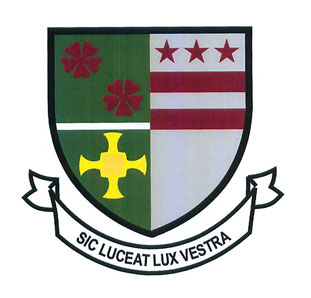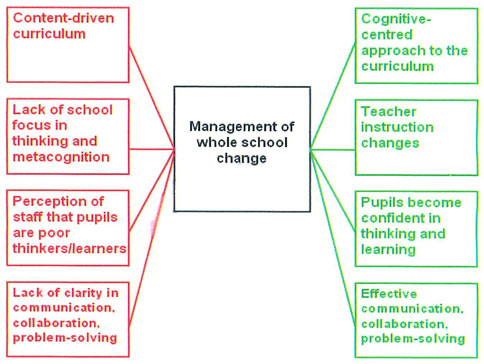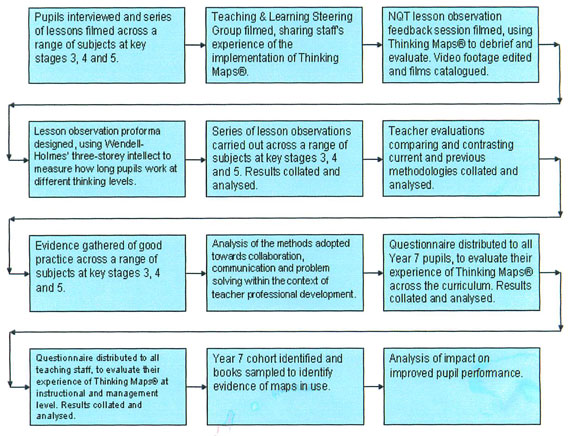



 St Robert of Newminster Catholic School
St Robert of Newminster Catholic Schooland Sixth Form College
United Kingdom
Thinking Maps and School Effectiveness
A Study of a UK Comprehensive School
Project Overview
Summary, Methods of Research, Anticipated Results
Thinking Maps® were introduced in September 2007 to all staff as a key strategy which will underpin the development of thinking at St Robert of Newminster Catholic School and Sixth Form College. The purpose of this strategy was to decrease the quantity of teacher instruction and transmission of knowledge in a content driven curriculum whilst increasing the amount of time dedicated to developing learning dispositions and thinking skills through student deployment of Thinking Maps® in their learning.

Methods of Research

Anticipated Results
We anticipate that our research will show that teacher collaboration and conversation will be more focussed and that these new dispositions and skills will lead to the development of common understandings, beliefs and practices about teaching for learning. As a consequence enhancement of teacher instructional effectiveness will significantly influence the learning that occurs for all members of the school community.
Intentions
It is the intent of this report to examine the role of Thinking Maps® in the transformation of teacher and pupil effectiveness. The report will detail the following specific areas of interest, before and after the implementation of Thinking Maps®:
- teacher instructional levels
- the amount of time pupils spend on higher order thinking
- teacher methodologies
- consistency and frequency of use
- examples of good practice
- analysis of pupils' perceptions of themselves as learners
- analysis of the methods adopted towards collaboration, communication
and problem solving within the context of teacher professional - development
- to determine whether there is a link between the use of Thinking Maps@
and improved pupil performance
Specific Areas of Interest
Until recently there has been no formal analysis of the time pupils spend on higher order thinking. We speculate that the implementation of Thinking Maps® has facilitated the change in teacher instructional levels, resulting in less time spent gathering and more time processing and applying.
In order to test this, we designed a lesson observation proforma utilising Oliver Wendell Holmes’ three-storey intellect, which focused on recording the amount of time pupils spent at each thinking level. Staff from a range of departments volunteered to participate in the lesson observation cycle.
Following the lesson observation, staff were asked to compare and contrast previous and current methodologies, highlighting where thinking and learning was supported by the use of Thinking Maps®.
In a large school with 120 teaching staff analysing the frequency and consistency of the use of Thinking Maps® could prove to be challenging. It was therefore decided to sample Y7 books, assessing where Thinking Maps® were being used.
To compliment the book sampling we have gathered examples of Thinking Maps® in use from a range of departments across the school. This will enable us to evaluate further the frequency, consistency and quality of maps in use. In addition to this, a questionnaire was completed by every pupil in Y7 in order for us to assess the impact the maps are having on our students’ learning.
Teachers and school leaders in 2006-7 concluded that there is a lack of school focus on thinking and metacognition at all levels within the School. There is also agreement that some learners perceive themselves as novice thinkers and do not progress in their thinking and learning strategies. Thus they remain poor thinkers and dependent learners and, as a consequence, progress for these students is less than their potential indicates. In an attempt to quantify this, we have used MALS (Myself As A Learner Scale) data with all Y7 pupils. At the end of the research phase, this self-assessment will be revisited, highlighting whether the introduction of Thinking Maps® has altered their perception of themselves as learners.
We hope to prove that as a consequence of a deliberate immersion strategy of adopting a cognitive approach to Teacher Professional Development - i.e. the use of Thinking Maps® in training, teacher observation and feedback, mentoring and coaching - teacher confidence and effectiveness will increase. Staff questionnaires were designed to evaluate the impact of Thinking Maps® at instructional and management levels. We will also test whether as a direct consequence of introducing Thinking Maps® as a whole school strategy, teachers change their instructional methodology leading to a rise in pupil achievement.
The Case Study sections are accessible in the links below and in the upper left column menu on each page of the St Robert Case Study.
- Project Overview
- Teacher Instructional and Higher Order Thinking Levels
- Teacher Methodologies
- Consistency and Frequency of Use
- Teacher Perceptions of Thinking Maps®
- Analysis of Pupils' Perceptions of Themselves as Learners
- Teacher Collaboration, Communication and Problem Solving
- Impact of Thinking Maps®
- Conclusion
- Video Clips